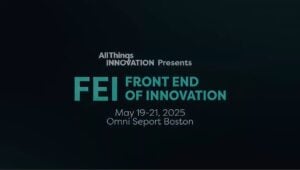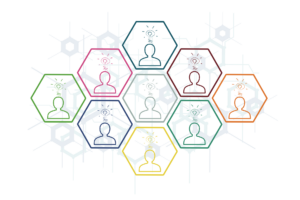KEY QUOTES
- “Trust became the underpinning of my work as a data leader, and I applied it to everything I did in that professional setting.” – June Dershowitz
- “People confuse scaling with the in-between moment, and the challenge we face is you don’t want to be at the end of the in-between moment because then you’re gonna be behind or out of business because there are fundamentally transformational things going on in this period.” – Arvind Balasundaram
- “I went from brainstorming, crossed that out to just problem seeking. And my goal was to just reframe my mindset… I’m gonna give myself three months, don’t do anything. Just search for problems and search for opportunities.” – Carley Hart
- “The biggest call out is how analytics is embedded in every stage of innovation and execution, right from starting with your goals to strategy, to flawlessly executing your standard offerings, and then innovating.” – Anu Sundaram
- “We’ve really gamified that approach. So all our projects, we keep track of the ideas that AI comes up with and the ideas that the team come up with. And then there’s the middle section, which is the hybrid… and guess which one always wins? It’s always the hybrid.” – Michael Ott
FULL TRACK SUMMARY
The AI, Data, Analytics & Insights Track at FEI25 presented a comprehensive exploration of how organizations can leverage data, analytics, and artificial intelligence to foster innovation and drive strategic growth. Across multiple sessions, experts shared frameworks, real-world examples, and actionable strategies for corporate changemakers to build resilient, data-driven innovation cultures.
Data Partnership for Innovation: Building Trust Through Quality, Alignment, and Literacy
June Dershewitz, a data leader with 25 years of experience, emphasized that trust is the bedrock of effective data partnerships. Her session, “Data Partnership for Innovation: Building Trust Through Quality, Alignment, and Literacy,” outlined three interconnected pillars: data quality, strategic alignment, and data literacy. Dershewitz highlighted that proactive data quality management, early integration of data teams into business initiatives, and targeted data literacy programs are crucial for fostering this trust. She stressed that data needs to have a “seat at the table” from the outset of any launch playbook, alongside design, PR, and legal, to ensure insights are embedded into decision-making. The core message was that effective data utilization is less about technical prowess and more about creating a foundation of trust that enables collaborative problem-solving and innovation.
Scaling AI Within Global Corporate Enterprise For Better Decision Making
The session “Scaling AI Within Global Corporate Enterprise For Better Decision Making” addressed the common challenges organizations face in moving AI beyond proof-of-concept stages. The speaker from Regeneron stressed the need for both technological and organizational readiness, emphasizing that scaling AI requires a clear strategic vision, not just project-based funding. A key concept introduced was the “in-between moment” – the critical period when emerging technologies are not yet mainstream but hold immense transformational potential. Companies that fail to invest during this phase risk falling behind. The presentation highlighted that AI should augment human decision-making, allowing for the separation of data processing from judgment-based decisions. This approach enables organizations to balance everyday efficiency gains with long-term transformational opportunities.
From Deep Tech to Picture Books: Innovation Strategies for AI Startups and Small Businesses
Carley Hart, in her session “From Deep Tech to Picture Books: Innovation Strategies for AI Startups and Small Businesses,” offered a unique perspective on applying robust innovation methodologies across diverse contexts. Drawing from her experience with deep tech startups at Cornell Tech and her venture into creating a children’s book business, Hart illustrated the universal applicability of design thinking. She advocated for “problem-seeking” as a foundational practice, moving beyond traditional brainstorming to continuously identify problems and opportunities. Hart’s process involved developing personal design criteria, embracing rapid, low-cost validation through minimal viable prototypes, and leveraging existing infrastructure. Her journey underscored that innovation principles can be scaled and adapted to drive solutions for a wide range of challenges, from complex technological problems to everyday consumer needs.
Aligning Innovation with Business Strategy Through Analytics
Anu Sundaram’s session, “Aligning Innovation with Business Strategy Through Analytics,” focused on how analytics can enable and accelerate the entire innovation lifecycle. He presented four constructs for using analytics in innovation: providing stage-specific analytics, ensuring early integration, allowing analytics to set the pace, and focusing on impact. Real-world examples from an e-commerce business demonstrated how data-driven decisions led to successful innovations, such as personalized emails and customer incentive programs that significantly improved customer lifetime value. The core takeaway was the imperative of embedding analytics at every stage of innovation—from initial goal setting and strategy development to flawless execution and ongoing iteration. Sundaram also emphasized the importance of developing “dual-horizon metrics” that track both immediate impact and long-term value, along with building alternate pathways to allow for agile pivots based on data feedback.
From Insight to Impact: How AI & People are Transforming Innovation at Clorox
Michael Ott’s session, “From Insight to Impact: How AI & People are Transforming Innovation at Clorox,” provided a compelling case study on revolutionizing an established company’s innovation process. Clorox implemented a hybrid model where AI-generated insights and human creativity work in concert. This approach dramatically accelerated the discovery process, reducing development time from nine months to three to four months, while simultaneously enhancing the quality of ideas. Fazio highlighted that the most successful innovations consistently emerged from this combined human-AI approach. Clorox also shifted its innovation metrics to measure success over a three-year period, promoting “sticky innovation” that ensures sustainable growth rather than short-term product launches. The session underscored the power of a synergistic relationship between technology and human ingenuity, alongside a leadership culture that actively drives, rather than delegates, innovation.
Driving Systemic Change: The Playbook to Reignite A Culture of Innovation
Erin Faulk and Sarah Stabelfeldt, in “Driving Systemic Change: The Playbook to Reignite A Culture of Innovation,” shared Schreiber Foods’ five-year journey to embed innovation into its organizational culture. Their approach centered on five key enablers: creating a dynamic shared vision, embracing non-linear change (the “snowball analogy”), demonstrating vulnerability, leveraging sprints for business challenges, and building post-sprint momentum. They treated the innovation adoption curve as a segmentation strategy, tailoring communication and engagement to different groups within the organization. This systemic transformation resulted in a significant number of activated solutions with measurable business impact, demonstrating how cultural shifts can directly translate into tangible business results. The session emphasized the importance of executive sponsorship, building an innovation champions network, and fostering a daily commitment to change and experimentation.
Introducing A Breakthrough Methodology to Fuel Front-End Innovation
The session “Introducing A Breakthrough Methodology to Fuel Front-End Innovation” introduced XMOT (Exact Moment of Truth), a novel approach using smart sensors to track real-time product usage and gather in-the-moment consumer feedback. This methodology directly addresses the “say-do gap” inherent in traditional research, where consumers’ stated intentions often differ from their actual behavior. By capturing authentic usage moments, XMOT provides transformative insights for product development, testing, and growth strategies. An example cited a cleaning product manufacturer achieving $600 million in incremental revenue through insights gained from this method. The session highlighted the power of real-time, in-context feedback for optimizing existing products and informing future innovations, including the application of A/B testing to physical product attributes.
KEY TAKEAWAYS
- Trust is Foundational for Data-Driven Innovation: Effective data partnerships and innovation efforts are built on trust, which requires proactive data quality management, early integration of data teams, and targeted data literacy across the organization.
- Strategic AI Adoption Augments Human Capabilities: Scaling AI successfully demands a clear vision that balances immediate efficiency gains with transformational opportunities, recognizing that AI should empower, not replace, human decision-making and creativity.
- Innovation Methodologies are Universally Applicable: Design thinking and problem-seeking approaches can be applied effectively across diverse scales, from large corporate initiatives to individual entrepreneurial ventures, by focusing on identifying problems and rapidly validating solutions.
- Analytics Must Be Integrated Throughout the Innovation Lifecycle: For innovation to align with business strategy, analytics must be embedded from ideation through execution, providing stage-specific insights, setting development pace, and informing decisions with both short-term and long-term impact metrics.
- Hybrid Human-AI Approaches Yield Superior Results: The most impactful innovations often emerge from a synergy between human creativity and AI-generated insights, highlighting the need for processes that deliberately combine these strengths to foster “sticky innovation.”
DELIVERY ON EVENT FOCUS:
Aligning Innovation with Business Strategy
The track consistently delivered on the focus of aligning innovation with business strategy by providing concrete examples and frameworks for connecting data, AI, and analytics directly to business outcomes. Sessions demonstrated how:
- Data quality and trust enable more reliable strategic decisions.
- AI strategies must balance efficiency with transformational opportunities to ensure future competitiveness.
- Innovation methodologies can be applied to solve specific business problems, whether in deep tech or consumer products.
- Analytics must be embedded at every stage of the innovation lifecycle, with dual-horizon metrics, to ensure initiatives contribute to both immediate and long-term strategic goals.
- Hybrid human-AI approaches accelerate innovation and improve quality, leading to measurable business impact over multi-year periods.
- Systemic cultural change drives activated solutions with measurable business impact, reinforcing organizational resilience.
- Real-time consumer insights directly inform product development and growth strategies, leading to significant incremental revenue.
Each speaker tied their discussions back to how their insights and methods directly impact business value, from revenue generation and efficiency gains to cultural transformation and competitive advantage.
DELIVERY ON EVENT THEME:
Harvesting Innovation & Sowing the Seeds of Future Growth
The track effectively addressed the theme of “harvesting innovation and sowing the seeds of future growth” by:
- Harvesting Innovation: Showcasing how organizations can extract immediate value from existing data through quality management and analytics, optimize current products using real-time consumer insights to unlock new revenue streams, and leverage existing knowledge and processes to create new ventures. The track also highlighted how systemic cultural transformation leads to “activated solutions” with measurable business impact, representing the harvesting of tangible results.
- Sowing the Seeds of Future Growth: Emphasizing the importance of investing in foundational capabilities like data literacy and robust data partnerships to create fertile ground for future innovation. It underscored the necessity of exploring transformational AI applications like synthetic data and causal AI, even if full implementation is years away. The concept of “problem-seeking” and continuously planting seeds for future innovation was a core message. Furthermore, the focus on long-term metrics and “sticky innovation” that grows over multiple years, rather than short-term launches, explicitly addressed sowing seeds for sustained growth. The entire cultural transformation journey at Schreiber Foods exemplified sowing seeds by building innovation capabilities and fostering experimentation across the organization.
ACTION STEPS FOR INNOVATION EXPERTS AND CORPORATE CHANGEMAKERS
To action the learnings from this track, innovation experts and corporate changemakers should:
- Strengthen Data Foundations: Assess your organization’s data quality framework and identify specific data literacy gaps, implementing targeted training and proactively including data teams early in all business initiatives to build trust and ensure data has a foundational “seat at the table.”
- Develop a Holistic AI Strategy: Move beyond isolated AI projects by defining a comprehensive AI strategy that balances immediate efficiency gains with long-term transformational opportunities, and educate stakeholders about AI capabilities and limitations in accessible language. Begin exploring emerging AI applications like synthetic data and causal AI now to prepare for future competitive landscapes.
- Embed Analytics Across the Innovation Lifecycle: Audit how early and thoroughly analytics is integrated into your innovation process. Restructure approaches to include analytics experts from the ideation stage, implement dual-horizon metrics (short-term impact and long-term value), and establish structured testing cycles with alternative pathways for agile pivots.
- Embrace Hybrid Human-AI Collaboration: Actively foster processes that combine AI-generated insights with human creativity. Evaluate your innovation metrics to encourage sustainable, multi-year “sticky innovation” platforms rather than just one-off product launches, and transform innovation leaders into “player-coaches” who actively participate.
- Cultivate a Culture of Continuous Problem-Seeking and Experimentation: Implement practices that encourage ongoing identification of problems and opportunities beyond time-constrained brainstorming. Embrace rapid, low-cost validation through minimal viable prototypes and build structured opportunities to share work-in-progress to gain early feedback and build buy-in for systemic change.
- Leverage Real-Time Consumer Insights: Evaluate current research methods to identify “say-do gaps” and explore piloting sensor-based, real-time research methodologies for physical products to gather in-context feedback, optimize existing offerings, and inform future product development based on actual consumer behavior.
Contributor
-

Seth Adler heads up All Things Insights & All Things Innovation. He has spent his career bringing people together around content. He has a dynamic background producing events, podcasts, video, and the written word.
View all posts




















































































































































